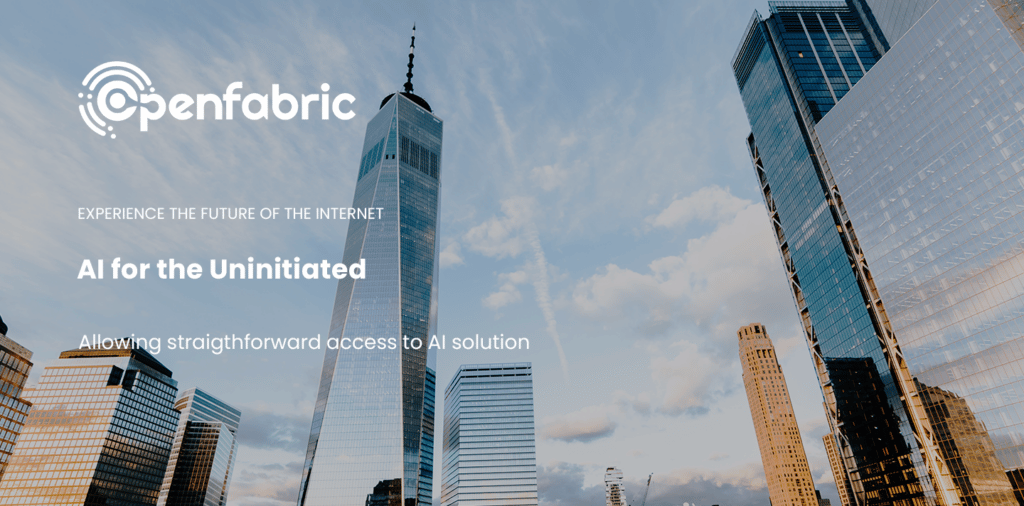
July 8, 2022 4 minutes read
AI for the Uninitiated

For those who are unfamiliar with Openfabric AI platform, today, we bring a brief explainer about what it is all about.
Artificial intelligence has become a widely known term, but getting started with AI is not an easy task. Openfabric has taken this fundamental issue and developed an easy-to-use platform that makes AI available to the masses. It is an AI platform that provides a number of different tools and resources that allow even the average internet user to harness the potential of AI in solving their desired problems.
What is Openfabric All About?
The vision statement of Openfabric makes its objective clear:
“To make AI easy to use and available for everyone”
The platform empowers users by providing them with a decentralized AI platform that works using distributed ledger technology (DLT). This backbone is topped up with an easy-to-use interface that does not require any technical background or knowledge to operate. This is a significant revolution as most of the existing AI environments are too exclusive and difficult to use.Plus the high cost of AI technology is itself a significant factor that deprives the majority of the proper use of AI.Openfabric not only addresses these issues but also caters to a wide variety of AI use cases and even helps monetize AI technology.
The Openfabric Architecture
Upon the DLT (distributed ledger technology) foundation, we have the Openfabric Network, the Openfabric Platform, and the stakeholders. The Openfabric network consists of services such as the Registry AI and data, Ontology, Execution, Warranty and Staking, Reputation and Rating, and Storage. A trusted execution environment connects with the stakeholders of the system. Next comes the Openfabric platform. It consists of the Openfabric Store, the Openfabric Toolkit, the Openfabric SDK and the Openfabric Daemon. Lastly, we have the Openfabric stakeholders that include service consumers, AI innovators, data providers, and infrastructure providers. All of these stakeholders work together to build turnkey AI solutions that are accessible to all. This architecture is the practical implementation of the Openfabric objective of “Creating the most inclusive and coherent community and marketplace for AI resources, developers and companies”.

Features of the Platform
Openfabric combines AI and blockchain into a decentralized feature set. Its main feature is that it commoditizes access to AI by reducing infrastructure demands and technical know-how. Secondly, its decentralized marketplace consolidates the business relationship between the supply and demand of AI services. This helps the community perform as an innovation engine by securing intellectual property and stimulating fair market competition amongst innovators.
Also among the vital features of the platform is the endless scalability that it offers. Any new infrastructure provider that adheres to the ecosystem’s requirements will be taking part in this endeavor. Trust and reliability are also core features of the system and play a vital role for users. The decentralized DLT ensures undeniable contracts and an unforgeable history between its stakeholders. The platform also offers AI interoperability. The standardized interfaces make this possible and permit multiple AI agents to cooperate and connect with each other.
Tech Overview
The technology used in Openfabric not only ensures the functioning of the core components of the system but also helps further the vision of an AI-powered, borderless economy and society where all the major problems are addressed using this technology. A Bayesian reputation model supervises the quality and performance of products and services through a reputation score based on community feedback. As we saw in the architecture section, the DLT ensures undeniable contracts and unforgeable history between the platform’s stakeholders. It also serves as the underlying layer for access control and identification mechanisms.
Achieving Nash equilibrium is possible when infrastructure providers offer excellent services, innovators generate high-quality algorithms that the community is willing to pay for and service consumers efficiently combine algorithms to obtain solutions for their specific use cases.
Conclusion
The Openfabric ecosystem is unparalleled in providing cutting-edge technology to the masses at an affordable cost while keeping ease of use in mind. The platform uses the latest AI technology, and the architecture is designed to provide maximum benefit to the growing community.
Want to learn more about the platform? You can find us at the following social handles:

